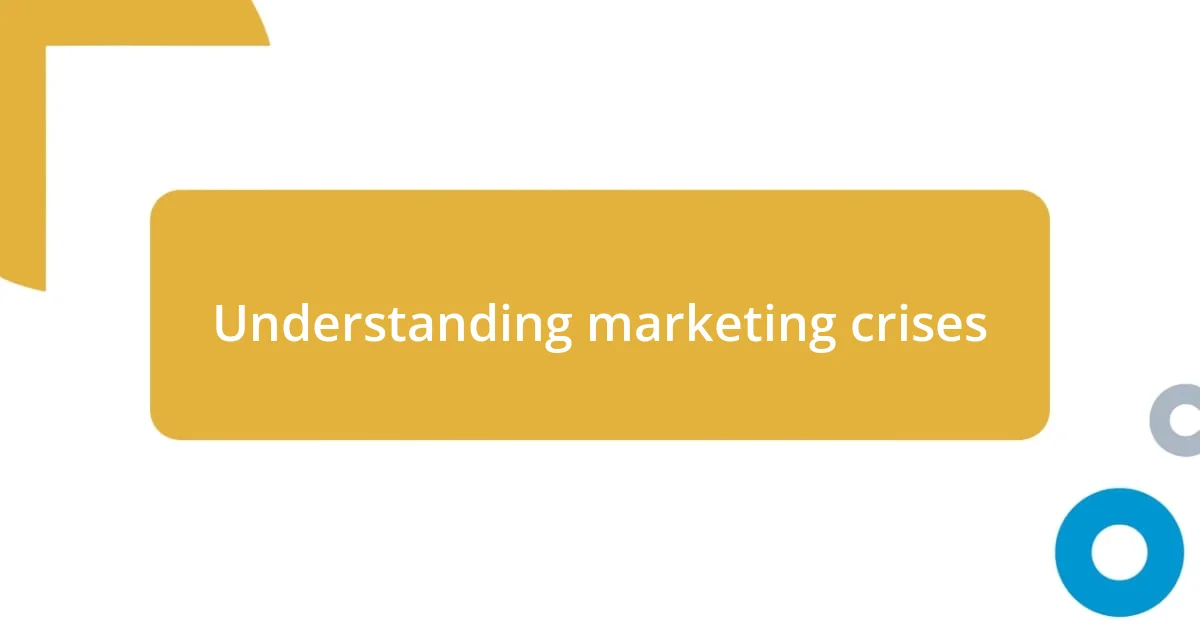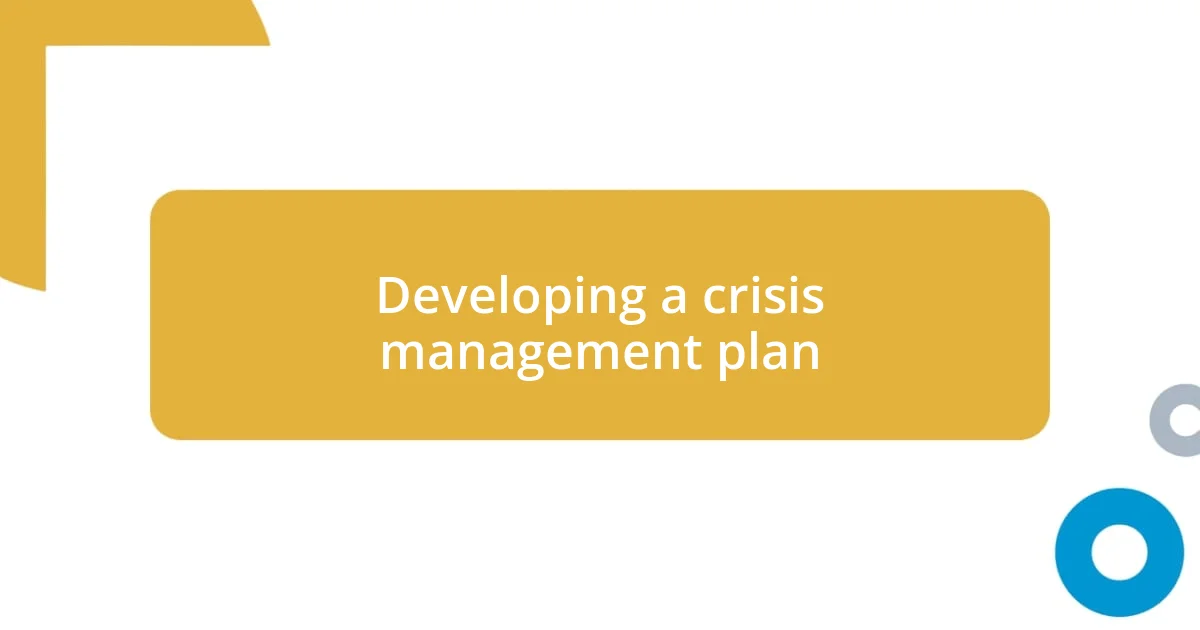Key takeaways:
- Early identification of signs, such as negative sentiment and analytics drops, is crucial for timely crisis management.
- A well-defined crisis management plan enhances team clarity and response effectiveness during high-pressure situations.
- Post-crisis evaluation focuses on both quantitative metrics and emotional connections, fostering trust and driving future improvements through ongoing audience engagement.

Understanding marketing crises
Marketing crises can feel overwhelming, often surfacing unexpectedly. I remember a time when a minor social media post spiraled into a major backlash, leaving us scrambling. It’s a stark reminder that what may seem trivial can snowball, turning into a crisis that tests our brand’s resilience.
When we think about what truly constitutes a marketing crisis, it goes beyond just a negative reaction. It’s about reputation, trust, and customer loyalty. Have you ever considered how quickly a single misstep can tarnish years of hard work? In my experience, it’s crucial to recognize that a crisis often exposes deeper issues within a brand that need addressing.
Navigating through a crisis requires swift action and clear communication. I learned this the hard way when we had to face a public relations nightmare. The anxiety was palpable. Even in chaos, the focus should always be on transparency and honesty. After all, how we respond can define not just the outcome, but our brand’s identity for years to come.

Identifying the initial signs
Identifying the early signs of a marketing crisis is crucial. In my experience, it often begins with subtle shifts in customer sentiment, like an uptick in negative comments on social media. The moment I noticed our brand’s tone beginning to shift from positive to uncertain, I felt a knot in my stomach—instinctively knowing something was wrong.
Another sign came through our analytics. I still remember the day our website traffic plummeted inexplicably, accompanied by a spike in bounce rates. This phenomenon was more than just a number; it felt like a wake-up call that demanded my immediate attention. I couldn’t shake the feeling that our audience’s interest was wavering, signaling an alarming shift.
Additionally, feedback from loyal customers can act as an early warning system. One time, a long-time client reached out to express confusion about our new messaging. Their candid words hammered home the idea that if someone who had been with us for years questioned our direction, we needed to pause and reassess. Listening to our customers isn’t just good practice; it felt like a bridge back to understanding our brand’s image.
| Initial Signs | Personal Insights |
|---|---|
| Negative Sentiment on Social Media | Immediate feeling of unease; shift in customer emotions. |
| Analytics Drop | Data presented a clear alarm; required swift action. |
| Feedback from Loyal Customers | Candid insights revealed areas needing adjustment; a true reflection of our brand. |

Developing a crisis management plan
Developing a crisis management plan is not just about having a written document; it’s about creating a proactive mindset within your team. During a past crisis, I learned that clarity in roles and responsibilities can make all the difference when tensions rise. I still remember the sense of relief when our team could rely on a well-defined plan that guided us step by step through our response.
Here’s a quick checklist to consider when developing your crisis management plan:
- Identify Potential Risks: Brainstorm potential scenarios that could impact your brand.
- Establish a Communication Protocol: Determine who communicates what, and when to external and internal audiences.
- Designate a Crisis Management Team: Select key individuals who will spearhead your response.
- Outline Key Messages: Prepare core messages that convey transparency and empathy.
- Simulate Crisis Scenarios: Run through mock situations to practice your response and improve coordination.
- Review and Revise Regularly: Keep the plan updated based on lessons learned and changing circumstances.
By having such a plan in place, I felt equipped to handle crises more calmly, knowing I wasn’t navigating blind. It’s about transforming potential panic into structured action, which, in my experience, is invaluable in maintaining a brand’s integrity during turbulent times.

Communicating with stakeholders effectively
Communicating with stakeholders during a crisis is an art that requires both precision and empathy. I distinctly remember one particular crisis when our PR team had to communicate swiftly with our investors. This experience taught me that transparency is key; I opted to share real-time updates, even the tough ones. I found that admitting a misstep can actually foster trust, allowing stakeholders to feel included in the narrative instead of sidelined.
Another lesson I learned was the importance of tailoring messages to different audiences. I once conducted a webinar specifically for our employees, allowing them to voice their concerns and ask questions directly. This open dialogue not only helped mend some frayed nerves but also made everyone feel like they were part of the solution. It reinforced my belief that effective communication turns a monologue into a conversation—something I strive for in every stakeholder interaction.
I’ve also come to appreciate the role of consistent follow-ups. After a major announcement, I initiated weekly updates through email and social media, ensuring our audience knew they were still on our radar. When I started receiving positive feedback about our proactive communication, it was a relief. It made me wonder: how many businesses miss out on valuable connections by not keeping their stakeholders in the loop?

Implementing damage control strategies
Implementing effective damage control strategies can feel overwhelming at first, but drawing from my past experiences can really simplify the process. Once, after an unexpected backlash on social media, I quickly gathered my team to brainstorm immediate actions. We focused on transparent acknowledgment of the issue and swiftly updated our communication across platforms. I noticed that when we owned up to our mistakes, we not only minimalized the backlash but also connected more authentically with our audience.
One strategy that proved invaluable was collaborating with brand advocates who could help amplify our message. I reached out to a few industry influencers who had a positive track record with our brand, and their support helped shift the narrative. It reminded me: who better to help during a crisis than those who genuinely believe in what you do? Their endorsement not only eased tensions but also demonstrated the power of community in overcoming challenges.
I also learned that empathy should be at the heart of every damage control effort. During our stride to recover, I made it a priority to engage directly with customer feedback, both negative and positive. I remember a particular moment when a frustrated customer reached out, and instead of deflecting, I took the time to listen and respond personally. This simple act made a difference – it not only softened the criticism but also transformed a complex situation into a meaningful interaction. Wouldn’t it be powerful if every brand took this human approach to crisis management? It certainly makes the path to recovery feel more like a shared journey rather than a solitary struggle.

Evaluating the outcomes
Evaluating the outcomes after navigating a marketing crisis is more than just assessing metrics; it’s about reflection and learning. I recall a time when I meticulously analyzed both qualitative and quantitative feedback after a campaign backlash. The data showed a decrease in engagement, but the real eye-opener was the direct comments we received from our audience. They expressed not only their dissatisfaction but also their hopes for improvement, making it clear that they were invested in our brand. How often do we overlook this wealth of insight?
Looking beyond numbers, I considered the emotional impact of our efforts. I remember how a heartfelt apology from our team resonated with our community. We hadn’t just righted a wrong; we had sparked conversations about accountability and growth. Evaluating those outcomes wasn’t just about correcting our course but rather understanding the emotional undercurrents we were dealing with. Isn’t it amazing how a genuine connection can transform the narrative?
Finally, I went deeper into the lessons learned and changes needed moving forward. After our recovery, we implemented regular feedback loops with our audience, and I took pride in seeing how our audience began to trust us more. Repeatedly seeking their input led us to innovate in ways that were previously unnoticed. This evolution made me wonder: how many brands miss the opportunity to evolve because they don’t take the time to listen? Through this introspection, we charted a course not just for recovery but for lasting improvement.

Learning lessons for the future
Learning from a marketing crisis involves looking back at the choices made and understanding their ramifications. For instance, I vividly recall a moment during one of our recovery phases when we discovered a significant gap in our communication strategy. Reflecting on that experience made me realize the importance of anticipating questions our audience might have before they even arise. Doesn’t it make sense to address concerns proactively instead of reactive apologies?
One powerful takeaway has been the value of fostering a culture of open communication within my team. I remember a brainstorming session post-crisis where everyone felt free to voice their opinions without judgment. This collective effort not only created innovative solutions but also bonded us more tightly as a unit. Isn’t it true that when we involve diverse perspectives, we enhance our ability to navigate future storms?
As we moved forward, I started embedding the lessons learned into our regular practices. I initiated workshops centered around crisis scenarios, encouraging my team to think critically about potential risks and responses. I can’t help but wonder: what if every brand took this approach? Facing challenges together not only sharpens skills but also nurtures resilience. With each crisis, I find that learning is not just a task—it’s a journey of growth that prepares us for whatever comes next.














